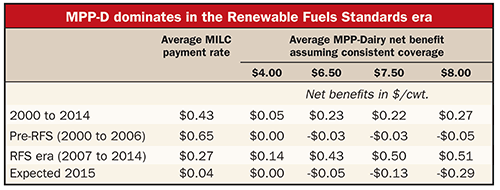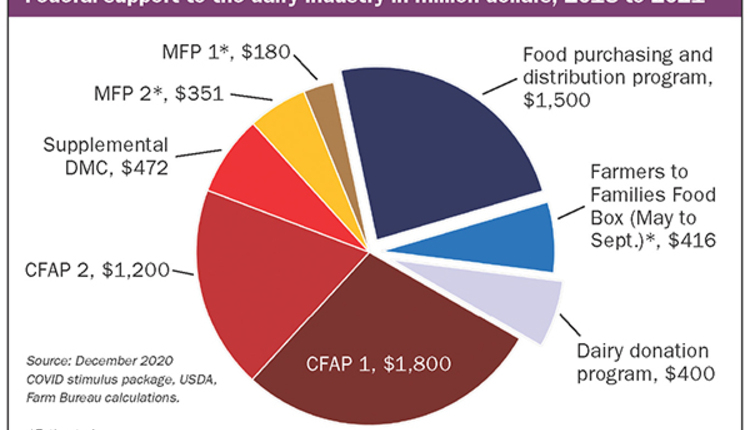Newtown is a clinical assistant professor in the Department of Agricultural and Consumer Economics at the University of Illinois-Urbana-Champaign. Bozic is an assistant professor in the Department of Applied Economics and associate director of Midwest Dairy Foods Research Center at the University of Minnesota.
It is often said that policymakers tend to "fight the last crisis," designing policies that address the latest problems which may not be relevant for future challenges. In the case of dairy policy in the farm bill, significant volatility in livestock feed prices - unimaginable before the Renewable Fuels Standards (RFS) - partially led to Congress foregoing the Milk Income Loss Contract (MILC) in favor of the Margin Protection Program (MPP-Dairy).
While the dairy safety net was being overhauled by Congress, grain farmers responded to higher grain prices in 2012 by planting and harvesting more corn and soybean acres across the U.S. In 2014, U.S. grain farmers harvested 14.2 billion bushels of corn and 3.9 billion bushels of soybeans, breaking records for both crops.

In 2015, risk to U.S. dairy farmer income once again seems to be on the revenue, not the expense, side of the ledger. For the 72 percent of U.S. dairy farmers with the minimum ($4 per cwt) or no MPP-Dairy coverage, our calculations using late-March futures prices suggest that the expired MILC program would have offered higher expected payments in 2015 than what they can expect this year under the new safety net. Absent upward movement in feed prices or declines in the milk price, MPP-Dairy payments are unlikely to cover the participation costs in 2015. Given these forecasts, have dairy leaders also been fighting the latest crisis, and should we now be feeling "buyer's remorse" over dairy safety net reforms?
To provide some perspective on the relative performance of MPP-Dairy and MILC, average program benefits from 2000 to 2014 were estimated assuming Tier 1 premiums for MPP-D and no eligibility constraints under MILC. This analysis keeps unchanged the historical supply and demand for dairy and is for illustration purposes only.
From 2000 to 2014, the average MILC payment rate was 43 cents per cwt. During the 2000 to 2014 period, consistent utilization of MPP-Dairy at the same coverage level each year would have provided average net payments as low as 5 cents for $4 per cwt. coverage and as high as 27 cents per cwt. for $8 per cwt. coverage.
However, 2000 to 2014 includes both the pre-RFS and RFS grain price data. It's generally accepted that the RFS era began in December 2006. Restricting the evaluation period to pre-RFS, we see that the average MILC benefit would have been 65 cents per cwt. In this pre-RFS era, the average MPP-Dairy benefits would have been negative 3 cents per cwt. when consistently utilizing $6.50 per cwt. coverage. Alternating coverage between $4 per cwt. and $8 per cwt. could have provided up to 18 cents per cwt. in benefits, 72 percent lower than under MILC. Not considering production constraints, MILC was the clear winner pre-RFS.
Once corn use for ethanol skyrocketed, feed costs nearly tripled, and the relative attractiveness of MILC and MPP-Dairy reversed, with average MILC benefits down to 27 cents per cwt., and benefits under MPP-Dairy for $6.50 per cwt. coverage rising to 43 cents per cwt. - nearly 60 percent higher than average MILC benefits. The contrast in performance, favoring MPP-Dairy during the RFS era, is overwhelming. In fact, MPP-Dairy would have outperformed MILC for all coverage options at $6 per cwt. and above during the RFS era (assuming Tier 1 premiums).
While we've recently experienced rapid reductions in milk prices, we've also experienced a decline in livestock feed prices due to back-to-back bumper crops. The downward pressure on feed prices has kept projected MPP-Dairy margins above the catastrophically low levels experienced during 2009 and 2012. As a result, the pattern of MPP-Dairy dominance in the RFS era will likely be tested in 2015.
A question this raises is if high grain price volatility experienced over the 2007 to 2014 period was a characteristic only of a few transition years, before the corn supply had a chance to respond to the new RFS-enhanced demand environment. If the grain markets were to settle with higher average grain prices, but the same risk as before 2007, then abandoning MILC in favor of MPP-Dairy may indeed be of questionable value.
To answer this question, we need to examine corn consumption dynamics by category. During a two-year period beginning in the 2006 to 2007 marketing year, the use of corn for ethanol rose by nearly 1.5 billion bushels and marketing-year-average corn prices doubled from $2 per bushel to over $4 per bushel. Following this rise in grain prices and consumption, three consecutive years of below-trend corn yields reduced production and brought carryover stocks to their lowest levels in nearly two decades. After the 2012 drought reduced grain inventories, it led to rationing of the corn supply in all consumption categories except ethanol.
While there has been a plateauing in corn use for ethanol production since 2010, the plateau is at a very high level, around 40 percent of total U.S. corn consumption. This level is not expected to rise or fall significantly as corn use for ethanol is capped under requirements of the RFS. What is critical to understand is that demand of corn for ethanol is very price inelastic due to RFS mandates that stipulate 13 to 15 billion gallons of conventional biofuels be blended into gasoline each year. The implication is that moderate yield shocks are more likely to result in strong corn price spikes, and the importance of that mechanism could be further amplified in the next two decades, as climate change could raise the likelihood of droughts in the Corn Belt.

Bottom line, we believe that a number of factors which combined to roil grain markets since 2007 are likely to persist. While 2015 may be a year where the risk to dairy profits are predominantly on the milk price side, going forward, we expect to see a long-term increase in feed price risk, justifying replacement of MILC with MPP-Dairy.
This article appears on page 243 of the April 10, 2015 issue of Hoard's Dairyman.
Return to the Hoard's Dairyman feature page.
It is often said that policymakers tend to "fight the last crisis," designing policies that address the latest problems which may not be relevant for future challenges. In the case of dairy policy in the farm bill, significant volatility in livestock feed prices - unimaginable before the Renewable Fuels Standards (RFS) - partially led to Congress foregoing the Milk Income Loss Contract (MILC) in favor of the Margin Protection Program (MPP-Dairy).
While the dairy safety net was being overhauled by Congress, grain farmers responded to higher grain prices in 2012 by planting and harvesting more corn and soybean acres across the U.S. In 2014, U.S. grain farmers harvested 14.2 billion bushels of corn and 3.9 billion bushels of soybeans, breaking records for both crops.

In 2015, risk to U.S. dairy farmer income once again seems to be on the revenue, not the expense, side of the ledger. For the 72 percent of U.S. dairy farmers with the minimum ($4 per cwt) or no MPP-Dairy coverage, our calculations using late-March futures prices suggest that the expired MILC program would have offered higher expected payments in 2015 than what they can expect this year under the new safety net. Absent upward movement in feed prices or declines in the milk price, MPP-Dairy payments are unlikely to cover the participation costs in 2015. Given these forecasts, have dairy leaders also been fighting the latest crisis, and should we now be feeling "buyer's remorse" over dairy safety net reforms?
Dairy programs in the RFS era
To provide some perspective on the relative performance of MPP-Dairy and MILC, average program benefits from 2000 to 2014 were estimated assuming Tier 1 premiums for MPP-D and no eligibility constraints under MILC. This analysis keeps unchanged the historical supply and demand for dairy and is for illustration purposes only.
From 2000 to 2014, the average MILC payment rate was 43 cents per cwt. During the 2000 to 2014 period, consistent utilization of MPP-Dairy at the same coverage level each year would have provided average net payments as low as 5 cents for $4 per cwt. coverage and as high as 27 cents per cwt. for $8 per cwt. coverage.
However, 2000 to 2014 includes both the pre-RFS and RFS grain price data. It's generally accepted that the RFS era began in December 2006. Restricting the evaluation period to pre-RFS, we see that the average MILC benefit would have been 65 cents per cwt. In this pre-RFS era, the average MPP-Dairy benefits would have been negative 3 cents per cwt. when consistently utilizing $6.50 per cwt. coverage. Alternating coverage between $4 per cwt. and $8 per cwt. could have provided up to 18 cents per cwt. in benefits, 72 percent lower than under MILC. Not considering production constraints, MILC was the clear winner pre-RFS.
Once corn use for ethanol skyrocketed, feed costs nearly tripled, and the relative attractiveness of MILC and MPP-Dairy reversed, with average MILC benefits down to 27 cents per cwt., and benefits under MPP-Dairy for $6.50 per cwt. coverage rising to 43 cents per cwt. - nearly 60 percent higher than average MILC benefits. The contrast in performance, favoring MPP-Dairy during the RFS era, is overwhelming. In fact, MPP-Dairy would have outperformed MILC for all coverage options at $6 per cwt. and above during the RFS era (assuming Tier 1 premiums).
MPP-Dairy is a long-run solution
While we've recently experienced rapid reductions in milk prices, we've also experienced a decline in livestock feed prices due to back-to-back bumper crops. The downward pressure on feed prices has kept projected MPP-Dairy margins above the catastrophically low levels experienced during 2009 and 2012. As a result, the pattern of MPP-Dairy dominance in the RFS era will likely be tested in 2015.
A question this raises is if high grain price volatility experienced over the 2007 to 2014 period was a characteristic only of a few transition years, before the corn supply had a chance to respond to the new RFS-enhanced demand environment. If the grain markets were to settle with higher average grain prices, but the same risk as before 2007, then abandoning MILC in favor of MPP-Dairy may indeed be of questionable value.
To answer this question, we need to examine corn consumption dynamics by category. During a two-year period beginning in the 2006 to 2007 marketing year, the use of corn for ethanol rose by nearly 1.5 billion bushels and marketing-year-average corn prices doubled from $2 per bushel to over $4 per bushel. Following this rise in grain prices and consumption, three consecutive years of below-trend corn yields reduced production and brought carryover stocks to their lowest levels in nearly two decades. After the 2012 drought reduced grain inventories, it led to rationing of the corn supply in all consumption categories except ethanol.
While there has been a plateauing in corn use for ethanol production since 2010, the plateau is at a very high level, around 40 percent of total U.S. corn consumption. This level is not expected to rise or fall significantly as corn use for ethanol is capped under requirements of the RFS. What is critical to understand is that demand of corn for ethanol is very price inelastic due to RFS mandates that stipulate 13 to 15 billion gallons of conventional biofuels be blended into gasoline each year. The implication is that moderate yield shocks are more likely to result in strong corn price spikes, and the importance of that mechanism could be further amplified in the next two decades, as climate change could raise the likelihood of droughts in the Corn Belt.

Bottom line, we believe that a number of factors which combined to roil grain markets since 2007 are likely to persist. While 2015 may be a year where the risk to dairy profits are predominantly on the milk price side, going forward, we expect to see a long-term increase in feed price risk, justifying replacement of MILC with MPP-Dairy.








